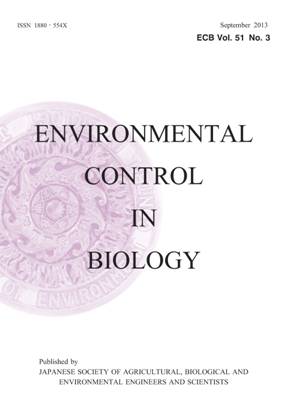
- Issue 4 Pages 87-
- Issue 3 Pages 45-
- Issue 2 Pages 15-
- Issue 1 Pages 1-
- |<
- <
- 1
- >
- >|
-
Naoto IWASAKI, Shinichiro HIRATSUKA2019 Volume 57 Issue 1 Pages 1-7
Published: January 01, 2019
Released on J-STAGE: January 12, 2019
JOURNAL FREE ACCESSThis study investigated the effects of tree morphology, including the above-ground body to root biomass ratio and organ size, on the severity of drought stress in Meiwa kumquat to elucidate the relationship between the severity of drought stress and number of first-flush flowers. Leaf water potential gradually decreased during the treatment of soil water deficit (SWD), and was negatively correlated with the dry weight of the trunk & old branch of the trees which was positively correlated with the number of first-flush flowers. Although transpiration from the trunk surface was confirmed, its rate was approximately 1/6th of that from the leaf surface under non-stressed conditions. The transpiration rate of trunk remained unchanged during SWD treatment but that of the leaf rapidly decreased. Therefore, the severity of drought stress was possibly dependent on the size of the trunk and old branches that may determine the amount of transpired water under drought conditions. Consequently, it may be preferable to employ parameters that indicate water status inside the trunk or scaffold branches rather than water potential of the leaves to understand how SWD treatment increases the number of first-flush flowers.
View full abstractDownload PDF (3543K)
-
Takanori HORIBE, Hirotaka SUMI, Shousei IMAI, Takuya MATSUOKA2019 Volume 57 Issue 1 Pages 9-13
Published: January 01, 2019
Released on J-STAGE: January 12, 2019
JOURNAL FREE ACCESSThis study aimed to investigate the effects of heavy metals on the growth of an edible cactus Nopalea cochenillifera. We exposed hydroponically grown cladodes of N. cochenillifera to different concentrations of heavy metals [arsenic (As), cadmium, and lead at 1, 10, and 100 ppm; Zinc (Zn) at 120, 1,200, and 12,000 ppm] for 14 weeks and assessed their growth. The underwater parts of the cladodes exposed to 10 and 100 ppm of As and 12,000 ppm of Zn showed rotting and did not produce any daughter cladodes. However, at all other concentrations, daughter cladodes emerged from the mother cladodes and continued to grow. The total fresh weight of the daughter cladodes and the dry weight of the emerged roots negatively correlated with heavy metal concentration. These results suggest that although high concentrations of heavy metals negatively affect the growth of N. cochenillifera cladodes, sometimes even killing them, this cactus can survive exposure to heavy metals at concentrations 100- to 10,000-fold higher than environmental standards of soil elution in Japan, indicating the potential of N. cochenillifera for phytoremediation.
View full abstractDownload PDF (2468K)
- |<
- <
- 1
- >
- >|